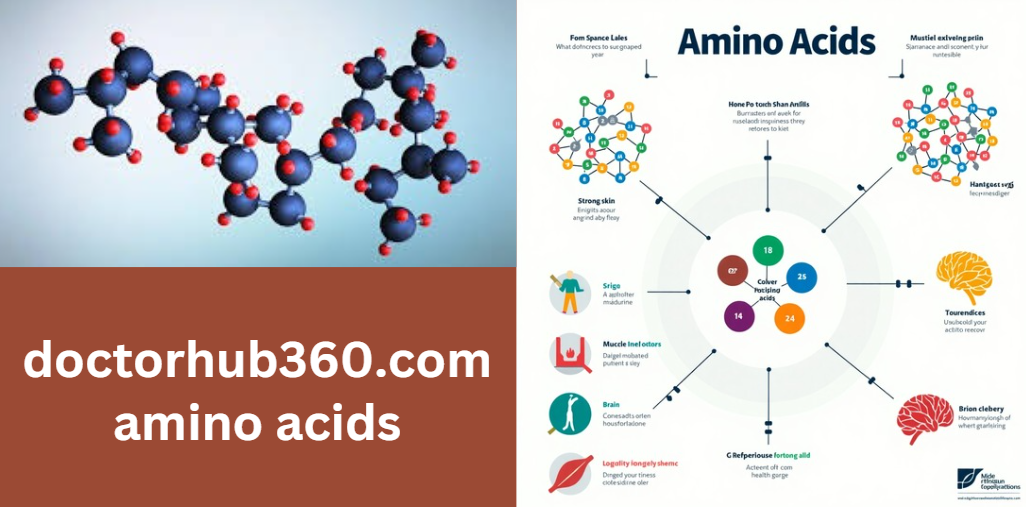Ultimate Guide to doctorhub360.com amino acids: In-Depth Information, Health Benefits & Dietary Tips
Amino acids are the fundamental components that form proteins, which in turn play crucial roles in nearly every aspect of human biology. In this guide, we break down the complex world of amino acids into clear, engaging sections. Our mission at doctorhub360.com amino acids is to educate, inform, and empower readers with the knowledge they need to make informed decisions about their diet and overall health.
Unlike other resources, our article not only covers the science behind amino acids but also dives into practical tips, dietary recommendations, and the latest research trends. By blending expert insights with easy-to-read content, we ensure that both beginners and health enthusiasts find valuable information.
The Basics of Amino Acids
What Are Amino Acids?
Amino acids are organic compounds characterized by the presence of both an amino group (―NH₂) and a carboxyl group (―COOH) attached to a central carbon atom (known as the α‑carbon). In addition to these groups, each amino acid features a unique side chain (R group) that determines its specific properties and role within proteins.
Proteins are essentially long chains of amino acids linked together by peptide bonds. When amino acids join, they form a polypeptide chain that folds into a three-dimensional structure—this structure is crucial for the protein’s function. The study of these molecules provides a window into understanding everything from muscle growth to enzyme activity.
The Process of Protein Synthesis
Protein synthesis is a fascinating and vital process in the human body. It starts when amino acids are assembled in a specific sequence, dictated by our DNA, into a polypeptide chain. This chain then folds into a complex structure, ultimately forming functional proteins that perform a myriad of tasks in the body. To help illustrate, consider the following simplified table:
| Component | Role |
|---|---|
| Amino Acids | Building blocks of proteins |
| Peptide Bond | Linkage between amino acids |
| Ribosomes | Cellular machinery that synthesizes proteins |
| mRNA | Template carrying the genetic instructions |
Understanding how proteins are synthesized is key to appreciating the role that amino acids play in maintaining overall health.
Classification of Amino Acids
Essential, Non-Essential, and Conditional
Amino acids are broadly categorized based on whether the body can synthesize them or not:
- Essential Amino Acids: These are amino acids that the human body cannot produce on its own, which means they must be obtained through dietary sources. There are nine essential amino acids, including histidine, isoleucine, leucine, lysine, methionine, phenylalanine, threonine, tryptophan, and valine.
- Non-Essential Amino Acids: Unlike essential amino acids, these can be produced by the body. Examples include alanine, asparagine, aspartic acid, and glutamic acid.
- Conditional Amino Acids: Under normal circumstances, these are not required in the diet; however, during periods of stress, illness, or injury, they may become essential. Arginine, cysteine, and glutamine are prime examples.
In a visually engaging list, we can summarize the types as follows:
- Essential Amino Acids: Histidine, Isoleucine, Leucine, Lysine, Methionine, Phenylalanine, Threonine, Tryptophan, Valine.
- Non-Essential Amino Acids: Alanine, Asparagine, Aspartic Acid, Glutamic Acid, etc.
- Conditional Amino Acids: Arginine, Cysteine, Glutamine, Tyrosine (under specific conditions), among others.
Detailed Breakdown of Essential Amino Acids
Below is an example of a detailed table listing the essential amino acids, their abbreviations, and key functions:
| Amino Acid | Abbreviation | Key Function |
|---|---|---|
| Histidine | His | Involved in growth and repair, precursor for histamine |
| Isoleucine | Ile | Critical for muscle repair and energy regulation |
| Leucine | Leu | Promotes protein synthesis, supports muscle recovery |
| Lysine | Lys | Essential for collagen formation, calcium absorption |
| Methionine | Met | Important for metabolism and detoxification processes |
| Phenylalanine | Phe | Precursor for neurotransmitters like dopamine and norepinephrine |
| Threonine | Thr | Vital for protein balance and immune function |
| Tryptophan | Trp | Precursor to serotonin, influences mood and sleep |
| Valine | Val | Essential for muscle metabolism and tissue repair |
This table not only informs the reader but also makes the content easier to scan and understand.
Biological Functions & Health Benefits
The Role of Amino Acids in Protein Synthesis
Proteins, synthesized from amino acids, are responsible for building and repairing tissues. They are essential for muscle growth, enzyme production, and maintaining the structure of cells and organs. When you consume foods rich in amino acids, your body uses these building blocks to create the proteins necessary for every biological process.
Metabolic and Energy Production
Many amino acids can be converted into glucose through gluconeogenesis, providing a backup energy source when carbohydrates are scarce. Additionally, amino acids play a role in metabolism by participating in various biochemical pathways that generate energy for the body.
Neurotransmitter and Hormone Production
Certain amino acids act as precursors to neurotransmitters and hormones. For example, tryptophan is converted into serotonin, which regulates mood, sleep, and appetite. Tyrosine, another amino acid, is involved in the production of dopamine and epinephrine—chemicals that have a direct impact on mental alertness and emotional balance.
Immune System Support and Tissue Repair
Amino acids are crucial for the repair and regeneration of tissues. They also bolster the immune system by serving as the raw materials for antibodies and other immune system components. This function is particularly important during recovery from illness or injury.
Dietary Sources & Nutritional Insights
Complete vs. Incomplete Proteins
Proteins in our diet can be classified as either complete or incomplete based on their amino acid profile. Complete proteins, which contain all nine essential amino acids, are typically found in animal products such as meat, eggs, and dairy. However, some plant-based foods like soy, quinoa, and buckwheat are also complete proteins. In contrast, many plant sources like nuts, seeds, and legumes may lack one or more essential amino acids; combining various incomplete proteins can help provide a balanced profile.
Below is a simplified table summarizing common food sources:
| Food Source | Protein Type | Key Amino Acid Insight |
|---|---|---|
| Beef, Poultry, Fish | Complete | Rich in all essential amino acids |
| Eggs & Dairy | Complete | High biological value, supports muscle repair |
| Soy, Quinoa, Buckwheat | Complete (Plant-based) | Ideal for vegetarian and vegan diets |
| Beans, Nuts, Seeds | Incomplete | Combine with grains for a balanced amino acid profile |
Supplementation and Daily Requirements
For those who might not receive sufficient amino acids from their diet, supplementation can be beneficial. However, it is important to understand both the benefits and potential drawbacks of supplements. An optimal daily intake varies based on age, activity level, and overall health. This guide also explores practical dietary tips and meal planning strategies to ensure you meet your amino acid requirements naturally.
Amino Acids in Diet & Lifestyle
Integrating amino acids into your daily routine goes beyond just eating protein-rich foods. Planning balanced meals and understanding your body’s nutritional needs can enhance muscle growth, support brain function, and boost overall well-being.
Meal Planning for Optimal Intake
Design your meals to include a mix of complete and complementary proteins. For example, combining legumes with grains in a salad or a stir-fry can help ensure you obtain all essential amino acids. Here’s a brief list of practical meal ideas:
- Breakfast: A smoothie with whey protein, banana, and almond butter.
- Lunch: A quinoa and black bean salad topped with avocado.
- Dinner: Grilled chicken paired with a variety of steamed vegetables and a side of brown rice.
Special Diet Considerations
For vegetarians and vegans, planning becomes even more critical. By mixing different plant-based protein sources throughout the day, you can ensure a complete amino acid profile. This section provides recipes, nutritional charts, and expert tips tailored for various dietary lifestyles.
In-Depth Scientific Insights & Research Updates
Latest Research on Amino Acid Functionality
Ongoing studies are continually revealing new insights about amino acids. Recent research has explored how amino acid supplementation can improve muscle recovery after intense exercise, support aging populations, and even influence mood and cognitive functions. For instance, several clinical studies indicate that balanced amino acid intake can lead to improved lean body mass and enhanced physical performance.
Future Trends and Innovations
The field of amino acid research is evolving rapidly. Emerging trends include personalized nutrition plans based on individual amino acid metabolism and the development of novel supplements that target specific health outcomes. Keeping abreast of these trends can help readers make informed decisions about their health.
Expert Opinions & Case Studies
Insights from Nutrition and Health Experts
Interviews with nutritionists, dietitians, and medical professionals provide practical insights on the importance of amino acids. These expert opinions help bridge the gap between scientific research and everyday health practices.
Real-Life Success Stories
Case studies and success stories from individuals who have optimized their health through better amino acid intake offer inspiration and practical examples. These narratives add a human element to the scientific information, making the content more relatable and engaging.
Frequently Asked Questions (FAQs)
How Do Amino Acids Contribute to Skin, Hair, and Nail Health?
Amino acids are not only vital for muscle and metabolic functions but also play a key role in maintaining the strength and resilience of skin, hair, and nails. They act as the building blocks for collagen and keratin, which are proteins essential for skin elasticity and hair/nail structure. A balanced intake of amino acids can help support skin repair, reduce signs of aging, and promote overall dermatological health.
Can Amino Acid Supplementation Enhance Cognitive Function?
Certain amino acids are precursors to neurotransmitters that regulate mood and brain activity. For example, amino acids like tryptophan and tyrosine are involved in the synthesis of serotonin and dopamine, respectively. While some studies suggest that supplementation may contribute to improved concentration and cognitive performance, the effects can vary depending on individual biochemistry and overall dietary patterns.
What Are the Potential Side Effects of Excessive Amino Acid Intake?
While amino acids are essential for health, consuming them in excessive amounts through supplements or diet can lead to imbalances. Some individuals may experience gastrointestinal discomfort, such as bloating or diarrhea, and in rare cases, high doses of certain amino acids might affect kidney function or interfere with the absorption of other nutrients. It’s important to follow recommended guidelines and consult with a healthcare professional before making significant changes.
How Do Athletes Specifically Benefit from Amino Acid Supplementation?
Athletes often turn to amino acid supplements to support recovery after intense exercise and to help build lean muscle mass. Branched-chain amino acids (BCAAs) in particular are known to reduce muscle soreness and promote protein synthesis, which may lead to faster recovery times and improved performance. However, the optimal dosage and timing of supplementation can vary based on training intensity and individual metabolic needs.
How Can Vegetarians Ensure They Receive a Balanced Amino Acid Profile?
Vegetarians may face challenges in obtaining all essential amino acids since many plant-based proteins are considered incomplete. By combining different plant sources—such as pairing legumes with grains—or by including naturally complete proteins like soy and quinoa in their meals, vegetarians can achieve a balanced amino acid profile. Planning meals with variety and diversity is key to meeting daily nutritional requirements.
Conclusion
In summary, this comprehensive guide on doctorhub360.com amino acids provides an all-encompassing overview of what amino acids are, their classifications, and the profound impact they have on our health.
By exploring everything from the science of protein synthesis to practical dietary strategies, we have created a resource that is not only informative but also actionable. Whether you are a health enthusiast looking to optimize your nutrition or simply curious about how amino acids work, this guide offers valuable insights to support your journey toward better health.
Thank you for reading our in-depth guide. Remember, your journey to optimal health begins with understanding the basics and making informed choices about your diet. Stay tuned to doctorhub360.com amino acids for more updates, expert tips, and the latest research in nutritional science.
Read more
Comprehensive Guide to us&j obituaries: History, Features, and How to Use
Comprehensive Guide to money6x investment trusts: Benefits, Risks & How to Invest
Ultimate Guide to how long does it take for stain to dry
Ultimate Guide to Nurture Tech Tips EmbedtreeUltimate Comprehensive Guide to the 8.17×5.64×3.52 diamond: Dimensions, Carat Weight, and Buying Tips





